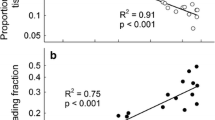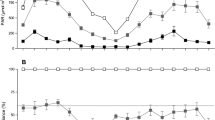Summary
The effect of full sunlight, 60%, or 90% attenuated light on photosynthetic rate, growth, leaf morphology, dry weight allocation patterns, phenology, and tolerance to clipping was examined in the glasshouse for steppe populations of the introduced grass, Bromus tectorum. The net photosynthetic response to light for plants grown in shade was comparable to responses for plants grown in full sunlight. Plants grown in full sunlight produced more biomass, tillers and leaves, and allocated a larger proportion of their total production to roots than plants grown in shade. The accumulation of root and shoot biomass over the first two months of seedling growth was primarily responsible for the larger size at harvest of plants grown in full sunlight. Plants grown under 60% and 90% shade flowered an average of 2 and 6 weeks later, respectively, than plants grown in full sunlight. Regrowth after clipping was greater for plants grown in full sunlight compared to those grown in shade. Even a one-time clipping delayed flowering and seed maturation; the older the individual when leaf area was removed, the greater the delay in its phenology. Repeated removal of leaf area was more frequently fatal for plants in shade than in full sunlight. For plants originally grown in full sunlight, regrowth in the dark was greater than for shaded plants and was more closely correlated to non-flowering tiller number than to plant size. This correlation suggests that etiolated regrowth is more likely regulated by the number of functional meristems than by differences in the size of carbohydrate pools. Thus, shading reduces the rate of growth, number of tillers, and ability to replace leaf area lost to herbivory for B. tectorum. These responses, in turn, intensify the effect of competition and defoliation for this grass in forests. B. tectorum is largely restricted to forest gaps at least in part because of its inability to acclimate photosynthetically, the influence of shade on resource allocation, and the role of herbivory in exacerbating these effects.
Similar content being viewed by others
References
Bazzaz FA, Carlson RW (1982) Photosynthetic acclimation to variability in the light environment of early and late successional plants. Oecologia 54:313–316
Belsky AJ (1986) Does herbivory benefit plants? A review of the evidence. Am Nat 127:870–892
Bjorkman O, Holmgren P (1963) Adaptability of the photosynthetic apparatus to light intensity in ecotypes from exposed and shaded habitats. Physiol Plant 16:889–914
Boardman NK (1977) Comparative photosynthesis of sun and shade plants. Annu Rev Plant Physiol 28:355–377
Bookman PA, Mack RN (1983) Competition between Bromus tectorum and Poa pratensis: the role of light. Oecologia 57:406–411
Caldwell MM, Richards JH, Johnson DA, Nowak RS, Dzurec RS (1981) Coping with herbivory: photosynthetic capacity and resource allocation in two semiarid Agropyron bunchgrasses. Oecologia 50:14–24
Corre WJ (1983) Growth and morphogenesis of sun and shade plants: I. the influence of light intensity. Acta Bot Neerl 32:49–62
Crawley MJ (1983) Herbivory, the dynamics of animal-plant interactions, University of California Press, Berkeley
Daubenmire R (1970) Steppe vegetation of Washington. Wash Agric Exp Station Tech Bull 62. Pullman, Washington
Daubenmire R, Daubenmire JB (1968) Forest vegetation of eastern Washington and northern Idaho. Wash Agric Exp Station Tech Bull 60. Pullman, Washington
Evans GC, Hughes AP (1961) Plant growth and the aerial environment. I. Effect of artificial shading on Impatiens parviflora. New Phytologist 60:150–180
Givnish TJ (1988) Adaptation to sun and shade: a whole-plant perspective. Aust J Plant Physiol 15:63–92
Grime JP (1979) Plant strategies and vegetation processes. John Wiley, New York
Harper JL (1977) Population biology of plants. Academic Press, London
Harris GA (1967) Some competitive relationships between Agropyron spicatum and Bromus tectorum. Ecol Monogr 37:89–111
Hunt R (1982) Plant growth curves. Edward Arnold, London
Huxley P (1967) The effects of artificial shading on some growth characteristics of Arabica and Robusta coffee seedlings. I. The effects of shading on dry weight, leaf area and derived growth data. J Appl Ecol 4:291–299
Jameson DA (1963) Responses of individual plants to harvesting. Bot Rev 29:532–594
Loach K (1970) Shade tolerance in tree seedlings. II. Growth analysis of plants raised under artificial shade. New Phytologist 69:273–286
Mack RN (1981) Invasion of Bromus tectorum L. into western North America: an ecological chronicle. Agro-Ecosystems 7:145–165
Mack RN, Pyke DA (1983) The demography of Bromus tectorum: variation in time and space. J Ecol 71:69–93
Maschinski J, Whitham TG (1989) The continuum of plant responses to herbivory: the influence of plant association, nutrient availability, and timing. Am Nat 134:1–19
McNaughton SJ (1983) Compensatory growth as a response to herbivory. Oikos 40:329–336
Olson BE, Richards JH (1988) Tussock regrowth after grazing: intercalary meristem and axillary bud activity of tillers of Agropyron desertorum. Oikos 51:374–382
Paige KN, Whitham TG (1987) Overcompensation in response to mammalian herbivory: the advantage of being eaten. Am Nat 129:407–416
Patterson DT (1979) The effects of shading on the growth and photosynthetic capacity of Itchgrass (Rottboellia exaltata). Weed Sci 27:549–553
Peterson DL, Bazzaz FA (1978) Life cycle characteristics of Aster pilosus in early successional habitats. Ecology 59:1005–1013
Pierson EA (1988) Limits to the distribution of Bromus tectorum in forests of eastern Washington and northern Idaho. Ph.D. Dissertation, Washington State University, Pullman, 132 pp
Pierson EA, Mack RN (1990a) The population biology of Bromus tectorum in forests: distinguishing the opportunity for dispersal from environmental restriction. Oecologia 84:519–525
Pierson EA, Mack RN (1990b) The population biology of Bromus tectorum in forests: effect of disturbance, grazing, and litter on seedling establishment and reproduction. Oecologia 84:526–533
Pyke DA (1986) Demographic responses of Bromus tectorum and seedlings of Agropyron spicatum to grazing by small mammals: occurrence and severity of grazing. J Ecol 74:739–754
Pyke DA (1987) Demographic reponses of Bromus tectorum and seedlings of Agropyron spicatum to grazing by small mammals: the influence of grazing frequency and plant age. J Ecol 75:825–835
Richards JH, Caldwell MM (1985) Soluble carbohydrates, concurrent photosynthesis and efficiency in regrowth following defoliation: a field study with Agropyron species. J Appl Ecol 22:907–920
Richards JH, Mueller RJ, Mott JJ (1988) Tillering in tussock grasses in relation to defoliation and apical bud removal. Ann Bot 62:173–179
Rickard WH (1960) The distribution of small mammals in relation to the climax vegetation mosaic in eastern Washington and northern Idaho. Ecology 41:99–106
Scheiner SM, Gurevitch J, Teeri JA (1984) A genetic analysis of the photosynthetic properties of populations of Danthonia spicata that have different growth responses to light level. Oecologia 64:74–77
Solbrig OT (1987) Adaptive characteristics of leaves with special reference to violets: In: Calow P (ed) Evolutionary physiological ecology. Cambridge University Press, Cambridge, pp 127–150
Steel RGD, Torrie JH (1980) Principles and procedures of statistics: a biometric approach (2nd Ed). McGraw Hill, New York
Walker D (1985) Measurement of oxygen and chlorophyll fluorescence. In: Coombs J, Hall DO, Long SP, Scurlock JMO (eds) Techniques in bioproductivity and photosynthesis. Pergamon Press, New York, pp 95–106
Author information
Authors and Affiliations
Rights and permissions
About this article
Cite this article
Pierson, E.A., Mack, R.N. & Black, R.A. The effect of shading on photosynthesis, growth, and regrowth following defoliation for Bromus tectorum . Oecologia 84, 534–543 (1990). https://doi.org/10.1007/BF00328171
Received:
Accepted:
Issue Date:
DOI: https://doi.org/10.1007/BF00328171




